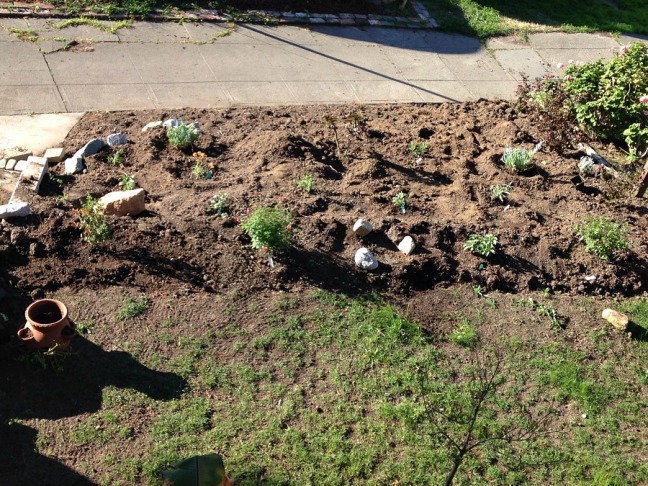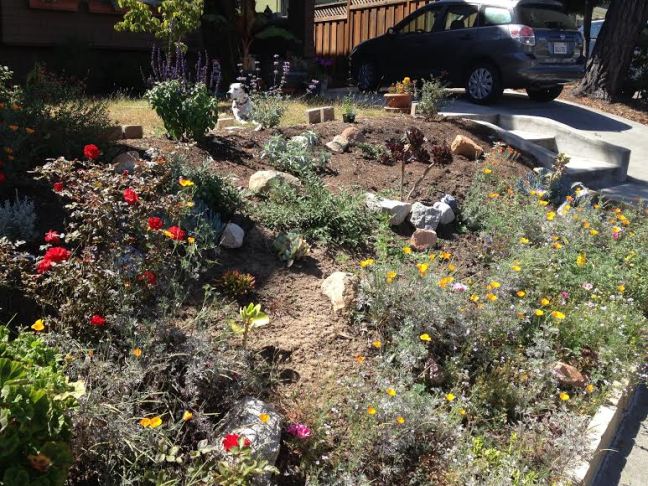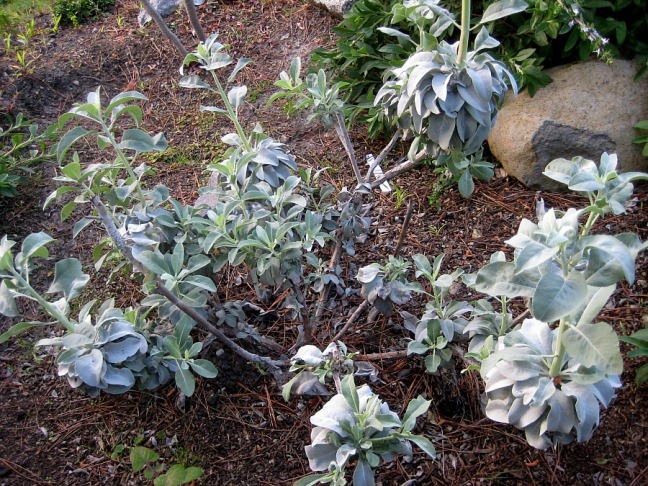One main reason I wanted to plant sage in my yard and all around my neighborhood three years ago, was to increase blessings to the area. My first Native mentor always said where sage grows, the land is sacred. But there was another reason too.
Things were changing in our area; crime was on the rise, car thefts were up, taggers were getting aggressive. Each day that I walked my dog, I found myself carrying a can of spray paint to cover the inevitable ugly, offensive, and meaningless marks made by ghosts of the night. It was getting old. I wanted to meet their destruction with something equally strong, more powerful. I wanted to make my own statement–in Beauty. Something to benefit my surroundings while simultaneously making an offering. To whom? you might ask. To the local land spirits, of course; the ones who were here long before we were.
I grew up accustomed to spirits from my desert childhood; everything felt alive. So to acknowledge spirits everywhere in the natural world, is well, natural to me, and not a distant shamanistic belief. I wanted to plant an offering garden that might awaken the sleeping spirits of the land to help protect us. So, I began by researching plants that were native to the area, and possibly native to our historic Temescal Tribes indigenous to the area.

The word Temescal derives from the Nahuatl word temazcali, meaning house of heat, a ceremonial place to be purified by sacred plants and smoke for spiritual and health reasons. This was common practice for ancient First Peoples across meso-America and North America (Photo:. The Spanish were the first to report that Temescal structures found in our local area were permanent structures, not temporary as sweat lodges are today. After studying up, I decided that a garden yard filled with sages would be a good offering; aromatics native to Northern California to draw hummingbirds (warrior spirits) and bees.
It was a lot of work. Removing the top root-bound soil layer was way tougher than I imagined. The grass root mass was rock hard in most places for 6-8 inches. I got advice from our nearby nursery: remove the top 4-6″ layer, dig another 3-4″ and mix in a nutrient rich topsoils. Those red ropes in the above shot are roots: part of a network belonging to the old pine tree 20 feet away. I had no idea pine roots could reach so far, and be so hardy! I planted about 10 different kinds of native sages, mostly aromatics. Here it is looking down from the roof.
Here it is looking down from the roof. I planned and planted for drainage or lack of it, in three tiers, with the drought-tolerant plants on the top of the incline, and more water-loving succulents and flowers at the bottom to receive any available drainage.
I planned and planted for drainage or lack of it, in three tiers, with the drought-tolerant plants on the top of the incline, and more water-loving succulents and flowers at the bottom to receive any available drainage.
![SageChula2014_2299[1]](https://sacredlandsage.files.wordpress.com/2017/03/sagechula2014_22991.jpg?w=648)
 Native plants grow fast. This is 2 years later.
Native plants grow fast. This is 2 years later.  This is last spring, before trimming. I always have to trim the bee and black sages back, away from the white sage: Salvia apiana needs full sun. And when the little white planting tag says “grows 4-6”; its true, they do! Give them space.
This is last spring, before trimming. I always have to trim the bee and black sages back, away from the white sage: Salvia apiana needs full sun. And when the little white planting tag says “grows 4-6”; its true, they do! Give them space. So this is my first sage garden. I learned much, about what sages like and how even a little shade from a nearby pine tree can stunt growth. But more importantly, growing sage replaced the residual fear of being under attack, with a sacred thing of beauty; a garden. And whether by magical intent or synchronicity, the taggers disappeared, crime has gone down, and things are quiet again. This home and hood effort extended from my yard, to all spaces in the neighborhood, to my planting more native sages around in other neighborhoods, near highways, and anywhere a little blessing might benefit an area.
So this is my first sage garden. I learned much, about what sages like and how even a little shade from a nearby pine tree can stunt growth. But more importantly, growing sage replaced the residual fear of being under attack, with a sacred thing of beauty; a garden. And whether by magical intent or synchronicity, the taggers disappeared, crime has gone down, and things are quiet again. This home and hood effort extended from my yard, to all spaces in the neighborhood, to my planting more native sages around in other neighborhoods, near highways, and anywhere a little blessing might benefit an area.
And this is how 15% of all purchases in my shops for Sacred Land Sage are spent; to buy more sage bushes that we plant in both city and open spaces.
I encourage everyone to do this, to plant a sage garden as an offering. Research your area for native sages (local nurseries readily impart this info), and plant your own sacred garden. Sages are ideal plant spirits; most are drought tolerant and deer resistant; they need water only the first year, and infrequently after that (during dry drought years). Most sages in the Saliva genus put out awesome purple and lavender flowers, and the bees and hummingbirds will LOVE you for the time you spent to create something beautiful!





Hey T.L.,
Such a transformation of your Beautiful Garden, my last visit I saw early stages, and beginnings of anticipated Beauty and Form. Your nurturing and Love have Produced an amazing Garden! Nice going Girl…..
Hugs,
MUM
LikeLiked by 1 person
:)))) Thank You Mumma!!! It has been healing. xoxo!
LikeLike